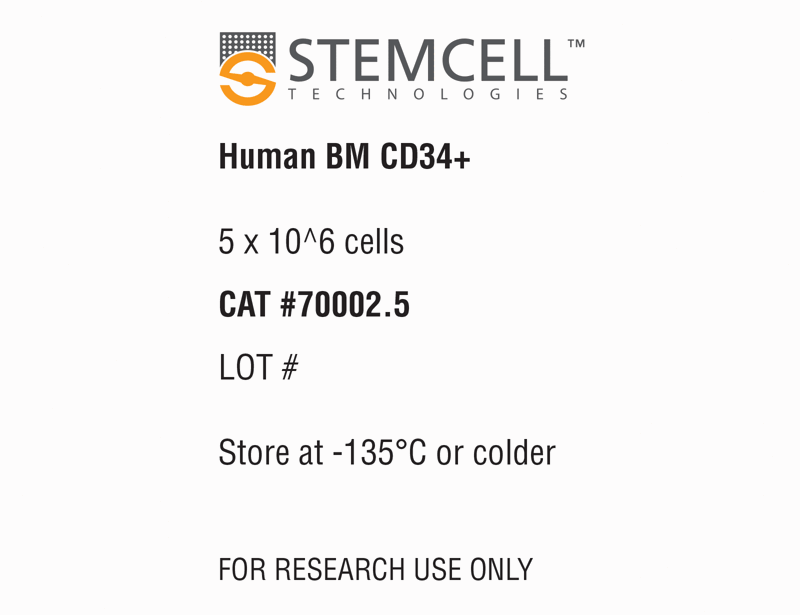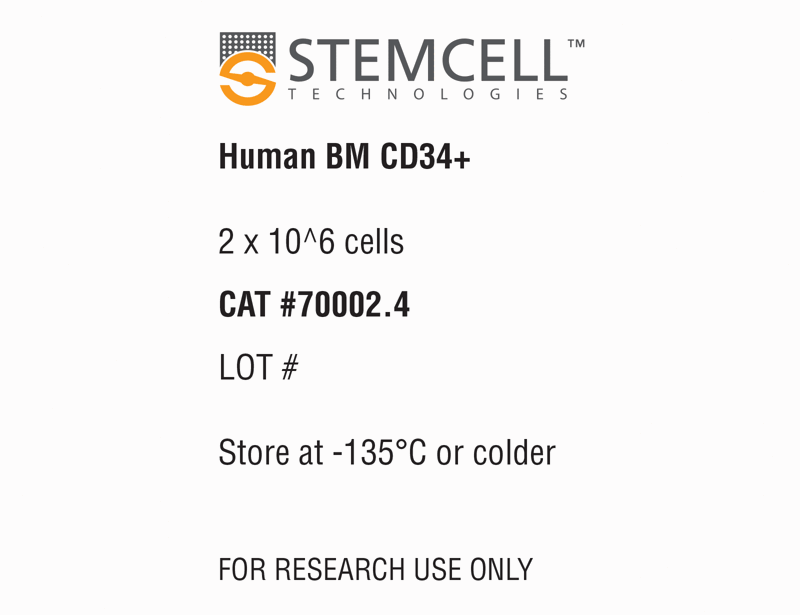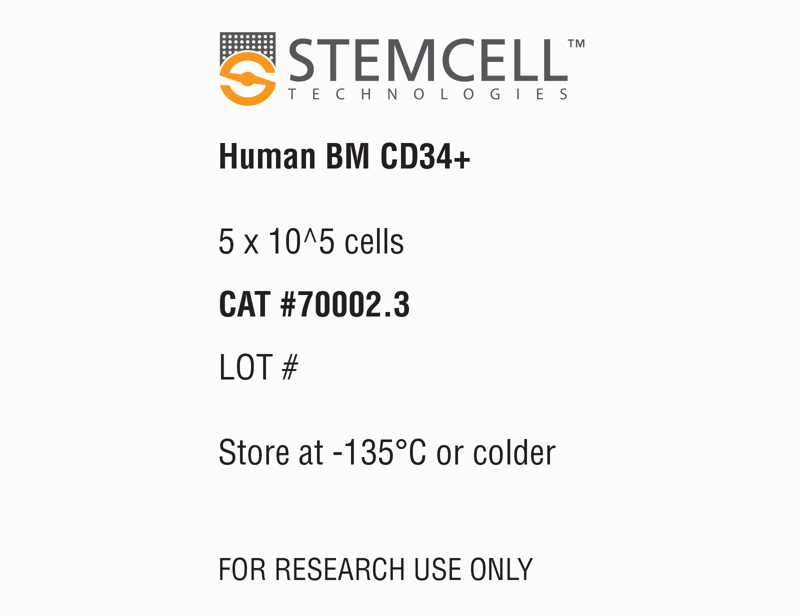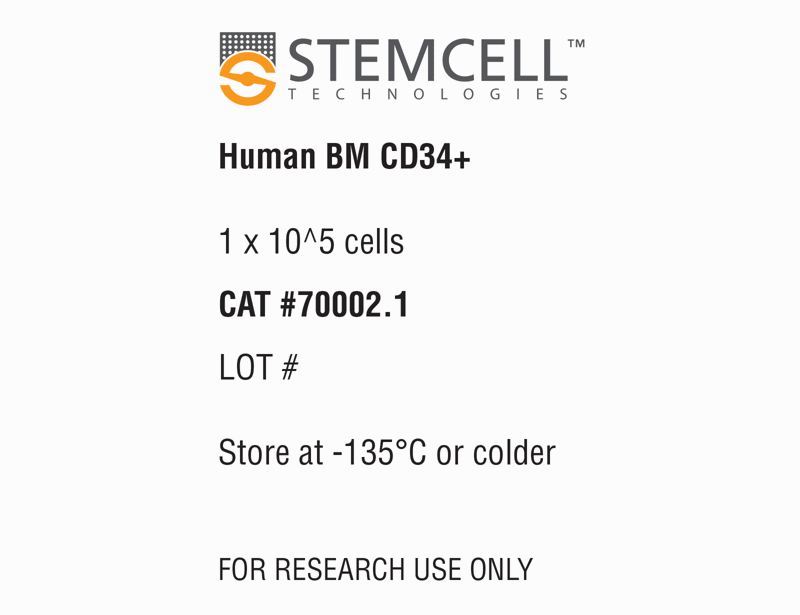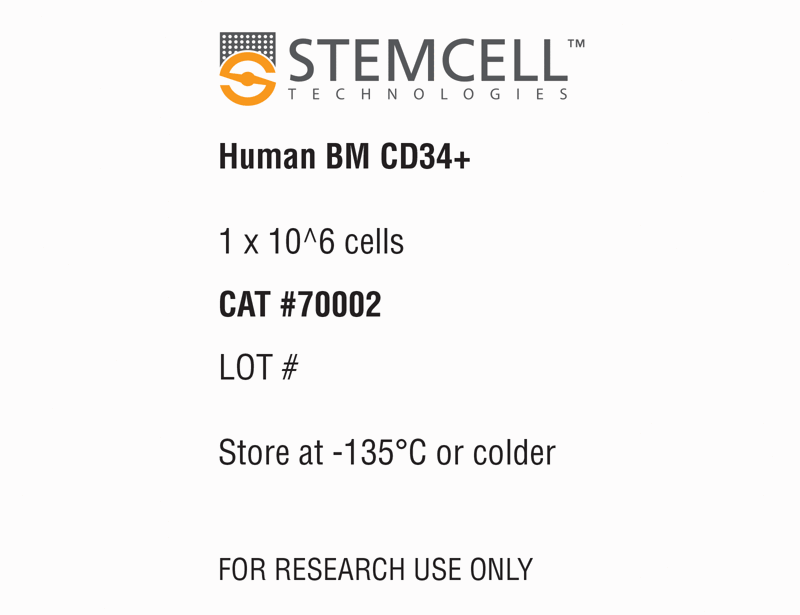Human Bone Marrow CD34+ Cells, Frozen
Primary human cells, frozen
概要
Human primary CD34+ cells isolated from human bone marrow (BM) mononuclear cells (MNCs) include hematopoietic stem and progenitor cells. CD34+ cells are isolated immunomagnetically using positive selection from human adult bone marrow. Heparin is added to the bone marrow during collection as an anticoagulant.
Bone marrow CD34+ cells can be used together with a number of products including StemSpan™, MyeloCult™, MethoCult™, and MegaCult™-S in order to study hematopoiesis and the differentiation of these rare cell types.
Cells were obtained using Institutional Review Board (IRB)-approved consent forms and protocols.
Certain products are only available in select territories. Please contact your local Sales representative or Product & Scientific Support at techsupport@stemcell.com for further information.
Browse our Frequently Asked Questions (FAQs) on Primary Cells.
Bone marrow CD34+ cells can be used together with a number of products including StemSpan™, MyeloCult™, MethoCult™, and MegaCult™-S in order to study hematopoiesis and the differentiation of these rare cell types.
Cells were obtained using Institutional Review Board (IRB)-approved consent forms and protocols.
Certain products are only available in select territories. Please contact your local Sales representative or Product & Scientific Support at techsupport@stemcell.com for further information.
Browse our Frequently Asked Questions (FAQs) on Primary Cells.
Contains
• Serum-free cryopreservation medium
• 10% dimethyl sulfoxide (DMSO)
• 10% dimethyl sulfoxide (DMSO)
Subtype
Frozen
Cell Type
Hematopoietic Stem and Progenitor Cells
Species
Human
Cell and Tissue Source
Bone Marrow
Donor Status
Normal
Purity
The purity of CD34+ cells is ≥ 90% by flow cytometry.
技术资料
| Document Type | 产品名称 | Catalog # | Lot # | 语言 |
|---|---|---|---|---|
| Product Information Sheet | Human Bone Marrow CD34+ Cells, Frozen | 70002, 70002.1, 70002.2, 70002.3, 70002.4, 70002.5 | All | English |
数据及文献
Publications (13)
Current protocols in toxicology 2018 MAY
An In Vitro Model of Hematotoxicity: Differentiation of Bone Marrow-Derived Stem/Progenitor Cells into Hematopoietic Lineages and Evaluation of Lineage-Specific Hematotoxicity.
Abstract
Abstract
Hematotoxicity is a significant issue for drug safety and can result from direct cytotoxicity toward circulating mature blood cell types as well as targeting of immature blood-forming stem cells/progenitor cells in the bone marrow. In vitro models for understanding and investigating the hematotoxicity potential of new test items/drugs are critical in early preclinical drug development. The traditional method, colony forming unit (CFU) assay, is commonly used and has been validated as a method for hematotoxicity screening. The CFU assay has multiple limitations for its application in investigative work. In this paper, we describe a detailed protocol for a liquid-culture, microplate-based in vitro hematotoxicity assay to evaluate lineage-specific (myeloid, erythroid, and megakaryocytic) hematotoxicity at different stages of differentiation. This assay has multiple advantages over the traditional CFU assay, including being suitable for high-throughput screening and flexible enough to allow inclusion of additional endpoints for mechanistic studies. Therefore, it is an extremely useful tool for scientists in pharmaceutical discovery and development. {\textcopyright} 2018 by John Wiley & Sons, Inc.
British journal of haematology 2018 AUG
Paediatric patients with acute leukaemia and KMT2A (MLL) rearrangement show a distinctive expression pattern of histone deacetylases.
Abstract
Abstract
Histone deacetylase inhibitors (HDACi) had emerged as promising drugs in leukaemia, but their toxicity due to lack of specificity limited their use. Therefore, there is a need to elucidate the role of HDACs in specific settings. The study of HDAC expression in childhood leukaemia could help to choose more specific HDACi for selected candidates in a personalized approach. We analysed HDAC1-11, SIRT1, SIRT7, MEF2C and MEF2D mRNA expression in 211 paediatric patients diagnosed with acute leukaemia. There was a global overexpression of HDACs, while specific HDACs correlated with clinical and biological features, and some even predicted outcome. Thus, some HDAC and MEF2C profiles probably reflected the lineage and the maturation of the blasts and some profiles identified specific oncogenic pathways active in the leukaemic cells. Specifically, we identified a distinctive signature for patients with KMT2A (MLL) rearrangement, with high HDAC9 and MEF2D expression, regardless of age, KMT2A partner and lineage. Moreover, we observed an adverse prognostic value of HDAC9 overexpression, regardless of KMT2A rearrangement. Our results provide useful knowledge on the complex picture of HDAC expression in childhood leukaemia and support the directed use of specific HDACi to selected paediatric patients with acute leukaemia.
Cancer cell 2017 OCT
Integrating Proteomics and Transcriptomics for Systematic Combinatorial Chimeric Antigen Receptor Therapy of AML.
Abstract
Abstract
Chimeric antigen receptor (CAR) therapy targeting CD19 has yielded remarkable outcomes in patients with acute lymphoblastic leukemia. To identify potential CAR targets in acute myeloid leukemia (AML), we probed the AML surfaceome for overexpressed molecules with tolerable systemic expression. We integrated large transcriptomics and proteomics datasets from malignant and normal tissues, and developed an algorithm to identify potential targets expressed in leukemia stem cells, but not in normal CD34+CD38- hematopoietic cells, T cells, or vital tissues. As these investigations did not uncover candidate targets with a profile as favorable as CD19, we developed a generalizable combinatorial targeting strategy fulfilling stringent efficacy and safety criteria. Our findings indicate that several target pairings hold great promise for CAR therapy of AML.
Journal of leukocyte biology 2017 MAY
A neutralizing anti-G-CSFR antibody blocks G-CSF-induced neutrophilia without inducing neutropenia in nonhuman primates.
Abstract
Abstract
Neutrophils are the most abundant WBCs and have an essential role in the clearance of pathogens. Tight regulation of neutrophil numbers and their recruitment to sites of inflammation is critical in maintaining a balanced immune response. In various inflammatory conditions, such as rheumatoid arthritis, vasculitis, cystic fibrosis, and inflammatory bowel disease, increased serum G-CSF correlates with neutrophilia and enhanced neutrophil infiltration into inflamed tissues. We describe a fully human therapeutic anti-G-CSFR antibody (CSL324) that is safe and well tolerated when administered via i.v. infusion to cynomolgus macaques. CSL324 was effective in controlling G-CSF-mediated neutrophilia when administered either before or after G-CSF. A single ascending-dose study showed CSL324 did not alter steady-state neutrophil numbers, even at doses sufficient to completely prevent G-CSF-mediated neutrophilia. Weekly infusions of CSL324 (%10 mg/kg) for 3 wk completely neutralized G-CSF-mediated pSTAT3 phosphorylation without neutropenia. Moreover, repeat dosing up to 100 mg/kg for 12 wk did not result in neutropenia at any point, including the 12-wk follow-up after the last infusion. In addition, CSL324 had no observable effect on basic neutrophil functions, such as phagocytosis and oxidative burst. These data suggest that targeting G-CSFR may provide a safe and effective means of controlling G-CSF-mediated neutrophilia as observed in various inflammatory diseases.
Molecular pharmacology 2015 AUG
Discovery and Characterization of Nonpeptidyl Agonists of the Tissue-Protective Erythropoietin Receptor.
Abstract
Abstract
Erythropoietin (EPO) and its receptor are expressed in a wide variety of tissues, including the central nervous system. Local expression of both EPO and its receptor is upregulated upon injury or stress and plays a role in tissue homeostasis and cytoprotection. High-dose systemic administration or local injection of recombinant human EPO has demonstrated encouraging results in several models of tissue protection and organ injury, while poor tissue availability of the protein limits its efficacy. Here, we describe the discovery and characterization of the nonpeptidyl compound STS-E412 (2-[2-(4-chlorophenoxy)ethoxy]-5,7-dimethyl-[1,2,4]triazolo[1,5-a]pyrimidine), which selectively activates the tissue-protective EPO receptor, comprising an EPO receptor subunit (EPOR) and the common β-chain (CD131). STS-E412 triggered EPO receptor phosphorylation in human neuronal cells. STS-E412 also increased phosphorylation of EPOR, CD131, and the EPO-associated signaling molecules JAK2 and AKT in HEK293 transfectants expressing EPOR and CD131. At low nanomolar concentrations, STS-E412 provided EPO-like cytoprotective effects in primary neuronal cells and renal proximal tubular epithelial cells. The receptor selectivity of STS-E412 was confirmed by a lack of phosphorylation of the EPOR/EPOR homodimer, lack of activity in off-target selectivity screening, and lack of functional effects in erythroleukemia cell line TF-1 and CD34(+) progenitor cells. Permeability through artificial membranes and Caco-2 cell monolayers in vitro and penetrance across the blood-brain barrier in vivo suggest potential for central nervous system availability of the compound. To our knowledge, STS-E412 is the first nonpeptidyl, selective activator of the tissue-protective EPOR/CD131 receptor. Further evaluation of the potential of STS-E412 in central nervous system diseases and organ protection is warranted.
Blood 2013 JUN
AML1-ETO mediates hematopoietic self-renewal and leukemogenesis through a COX/β-catenin signaling pathway.
Abstract
Abstract
Developing novel therapies that suppress self-renewal of leukemia stem cells may reduce the likelihood of relapses and extend long-term survival of patients with acute myelogenous leukemia (AML). AML1-ETO (AE) is an oncogene that plays an important role in inducing self-renewal of hematopoietic stem/progenitor cells (HSPCs), leading to the development of leukemia stem cells. Previously, using a zebrafish model of AE and a whole-organism chemical suppressor screen, we have discovered that AE induces specific hematopoietic phenotypes in embryonic zebrafish through a cyclooxygenase (COX)-2 and β-catenin-dependent pathway. Here, we show that AE also induces expression of the Cox-2 gene and activates β-catenin in mouse bone marrow cells. Inhibition of COX suppresses β-catenin activation and serial replating of AE(+) mouse HSPCs. Genetic knockdown of β-catenin also abrogates the clonogenic growth of AE(+) mouse HSPCs and human leukemia cells. In addition, treatment with nimesulide, a COX-2 selective inhibitor, dramatically suppresses xenograft tumor formation and inhibits in vivo progression of human leukemia cells. In summary, our data indicate an important role of a COX/β-catenin-dependent signaling pathway in tumor initiation, growth, and self-renewal, and in providing the rationale for testing potential benefits from common COX inhibitors as a part of AML treatments.

